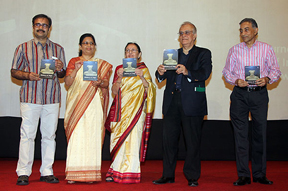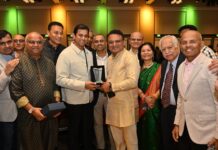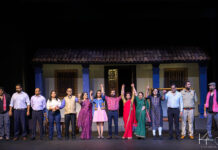
Elizabeth Visuvalingam The result of six years of extensive research and filming, with 30 scholar
contributions, showing 84 archeological sites and 137 locations, visiting 37 museums, libraries, temples, shrines, “History of Yoga – Path of My Ancestors,” is a 109-minute English documentary released in DVD by Vishuddhi Films and Madhya Pradesh Madhyam in USA last month.
Directed by Deepika Kothari and Ramji Om, it is now being distributed in North America at $24. This labor of love may be better described as a recapitulation of the spiritual basis of Indian culture, from its very beginnings.
The textual backbone and anchor of the exposition is the still extant Yoga Sutras of Patanjali formulated in the early centuries of the Common Era, while the encompassing worldview is provided by its sister cosmogony of Samkhya. Patanjali’s often cryptic 196 aphorisms outline a progression of practice ascending from yama or restraints (nonviolence, truthfulness, non-theft, chastity and non-possessiveness), niyama or disciplines (purity, contentment, etc.), stable comfortable posture (asana), breath-control (pranayama), concentration (dharana), meditation (dhyana) to complete absorption (samadhi) in the transcendental principle. India’s distinctive civilizational features are seen as societal effects of the pursuit of such spiritual techniques.
The non-militaristic character of Indus-Sarasvati Civilization (3400 to 1800 BCE), its sophisticated drainage network and immense baths, would reflect the preoccupation with nonviolence (ahimsa) and purity (cleanliness), embodied by the horned “lord of animals” (pashupati) seated in bhadrasana posture amidst reverent beasts and the “priest-king” depicted in seals and figurines. Familiarity at the popular level with yoga-like postures is evidenced by many terracotta images of the contorted human torso.
The Vedic tradition, though centered on the collective performance of the external sacrifice (yajna), remains studded with its associated themes such as mystic physiology (nadis) that are treated explicitly in later Upanishadic literature.
Though Patanjali mentions devotion to God as facilitating emancipation, his Sutras do not propose any theology and its Samkhya sister-doctrine is atheistic. That the experiential ‘science’ underlying yoga is the basis also of medicine and (Sanskrit) grammar is given credence through the medieval claim that Patanjali likewise purified the body and speech making them instruments of self-liberation.
The focus on body, mind and consciousness has facilitated this inner experiential “technology” being adopted and adapted by otherwise competing, even heterodox, doctrinal streams such as Jainism, Buddhism, and theistic devotional currents, such as Shaivism, Vaishnavism and Islam.
Central to early Buddhist monasticism, it later became the inspiration for an entire school of thought and practice called Yogacara that underlined the absolute primacy of Consciousness and thus deeply influenced Vedantic monism (advaita). In terminology and approach, Patanjali Yoga is in some ways perhaps closer to Buddhistic meditation than to Samkhya.
Yoga practices were however not dependent on textual erudition and elite culture for their propagation, development and diffusion beyond sectarian boundaries, as demonstrated by later Nath and Baul traditions, whose often illiterate adepts captured the popular imagination. In attempting a comprehensive panorama of yoga from other sources, the documentary, unwittingly relativizes and problematizes the significance of the Sutras.
Samkhya dualism posits two fundamentally distinct, male and female principles: aloof inactive consciousness (purusha) versus insentient dynamic nature (prakriti). By disentangling the two, its “path of knowledge” aims to detach the suffering finite self from its superimposed human identity. Patanjali Yoga constitutes the practical aspect of this dis-identification from mental and physical limitations.
Because Prakriti is depicted as a seductive woman under whose spell Purusha has fallen, the Samkhya-Yoga framework is derived from a matriarchal, still surviving, prehistory where the Mother Goddess reigned supreme before being overlaid and domesticated by brahmanical patriarchy.
This cultic context is seen in the architectural vestiges of the medieval Yogini temples. The psychophysical methods that (re-) emerge in trans-sectarian Tantra would be therefore more faithful to the ‘original’ outlook than the Purusha-centered ‘vision’ (darshana) privileged by classical Samkhya-Yoga.
The 112 techniques compiled (by 800 CE) as the esoteric Vijnana-Bhairava Tantra also exploit sensual (gustatory and sexual) enjoyment and agitated states (anger, fear, disgust, laughter, etc.)-mental modifications (citta-vritti) that Patanjali Yoga aims to suppress-as springboards to spiritual insight. In other words, the detachment or “ascent” of consciousness from the clutches of matter is complemented by its “re-descent” into embodied existence as autonomous agent imbued with power.
The latter aesthetic perception of life appeals especially to artists and those artisans, who seem to have crafted astounding creations after having meditated on their inner essence. This is the lesson drawn from the three-faced Shiva of the Ellora cave, fearsome on one side balanced by the effeminate on the other, mediated by the tranquil middle face.
Indian music is rooted in the “yoga of sound” (nada) as Ustad Zia Mohiuddin Dagar demonstrates by eking out various mantras on his veena. Sufis, especially from the Qadiri order, readily assimilated its elements into their meditative practices focused on repeating (dhikr) the holy names of God.
The tradition was transplanted in the late 19th century through Swami Vivekananda’s Raja Yoga lectures to America, where the associated physical postures have become a multimillion dollar health industry. Prime Minister Narendra Modi proposed an International Day of Yoga at his October 2014 address before the United Nations, a call since endorsed by over 175 other nations and fixed as June 21.
The only Hindu member of Congress, Tulsi Gabbard, has publicly championed this initiative. “History of Yoga” that the Indian Government has now sent for screening to all its missions abroad is a readily accessible, comprehensive and laudable attempt to re-anchor this exploding global interest within its original, ancient religio-cultural context.





